
The First and Only Weekly Online Fanzine Devoted to the Life and Works of Edgar Rice Burroughs
Since 1996 ~ Over 15,000 Webpages and Webzines in Archive
Volume 6749
TARZAN AND JANE DOWN UNDER
BY ROBERT ALLEN LUPTON
Rod Taylor: Australian Tarzan
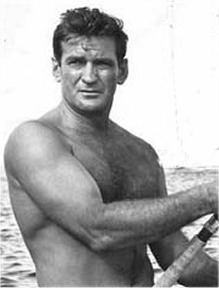
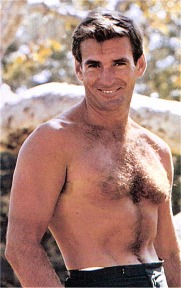

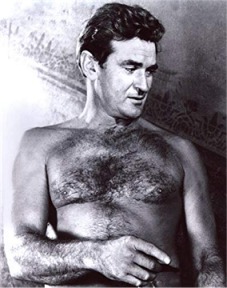





While I wasn’t paying attention, Tarzan and Jane spent some time in Australia. I was only six years old at the time. That’s my excuse and I’m sticking to it.There are three Tarzans and three Janes from the entertainment industry that you’ve probably never heard of – at least in those roles. Two of the Tarzans became well known, one of the Janes died in a tragic accident, and the narrator became famous in his own right. The actors and actresses stared in Tarzan, King of the Apes. The Tarzan radio program was broadcast throughout Australia during the early 1950s and locally on some regional radio stations in Australia as late as the early 1960s.
Originally, Australian radio imported and broadcast 104 Tarzan radio shows from America. The American episodes were from the Commodore radio show staring Lamont Johnson as Tarzan (http://www.erbzine.com/mag23/2337.html) After broadcasting the American episodes, the Australians produced 1040 (according to ERBzine) 12-minute episodes of their own down under radio show, Tarzan, King of the Apes. The Australian Film Archives has copies of over twenty scattered programs from number 3 to programs in the 700s. I have requested, but not been able to obtain copies.
These 1950s programs were written, produced, and performed by Australians. These programs are not easy to find. The Australian National Film and Sound Archives (ANFSA) has some holdings of these shows but by no means a complete set. The ANFSA website has a listing of old-time radio in its holdings at http://www.nfsa.afc.gov.au/docs/collectionguide_australianradi oseries1930-1970.pdf The entry for the Tarzan radio shows is as follows: TARZAN Series: 143575 Series. Contributors listed are Walter Pym (PDR), Jim Bradley (PDR), Contributors: Nigel Lovell (PDR), Brian Wright (SCR), Russell Writer (SCR), Artransa (PDC), Roger Climpson (NRT). Cast: Rod Taylor (Tarzan), Lloyd Berrell (Tarzan), Ray Barrett (Tarzan), Marcia Hathaway (Jane), Pamela Page (Jane), Joan Landor (Jane), Nigel Lovell, and Charles ‘Bud’ Tingwell. Label: Artransa Label. Episodes produced: 642 (at least) Broadcast details: 1954- ; Monday to Friday on 2GB 6 pm.
Two of the episodes are available at:
http://www.erbzine.com/mag0/tarzanoz1.mp3
http://www.erbzine.com/mag0/tarzanoz2.mp3Rod Taylor was the first Tarzan on the radio show. Taylor’s acting career evolved from his work as an artist and he started in radio, which was booming in Australia during the 1950s.
While still attending East Sydney Technical and Fine Arts College, he saw Sir Laurence Olivier and the Old Vic Company in “Richard III,” and was inspired to become an actor.
“But ... I didn’t know anything about acting. I had to earn some money to pay for tuition at the Independent Theatre, where I planned to study. So I faked my age [he was 17] and got a job with Mark Foy’s department store, designing and painting backdrops for window displays and fashion shows. ... I worked at Mark Foy’s during the day and studied drama at night. ...
“After a year or a bit more, I managed to get into radio. ... I did about 20 different daytime shows a week, hopping from studio to studio, playing every imaginable character in soap operas and stuff.”-- People Magazine (Australia), Jan. 25, 1967Taylor acquired extensive radio and stage experience in Australia, where his radio work included a period on Blue Hills and the role as Tarzan. Earlier in his career he had to support himself by working at Sydney’s Mark Foy’s department store, designing and painting window and other displays during the day. In 1951, he took part in a re-enactment of Charles Sturt’s voyage down the Murrumbidgee and Murray Rivers, playing Sturt’s off-sider, George Macleay. A short documentary, Inland with Sturt (1951), was based on it. Taylor also appeared in a number of theatre productions for Australia’s Mercury Theatre.Taylor made his feature film debut in the Australian Lee Robinson film, King of the Coral Sea (1954), playing an American. He later played Israel Hands in a Hollywood-financed film shot in Sydney, Long John Silver (1954), an unofficial sequel to Treasure Island.
It was a radio honor, the Rola Award as actor of the year, that sent Taylor on his way to Hollywood. The Rola Show was a half-hour program featuring local actors in original Australian dramas. Each week, listeners nominated an actor who would compete for the final prize. In 1954, Rod won that prize for his performance in the dual role of a father and son in the drama O’Sullivan’s Bay. The award provided him with £500 and a round-trip ticket to London. Instead, he stopped in Hollywood and found a new career on the screen.
Taylor soon landed roles in television shows such as Studio 57 and the films, Hell on Frisco Bay (1955) and Giant (1956). In 1955, he guest-starred as Clancy in the third episode (“The Argonauts”) of the first hour-long Western television series, Cheyenne, an ABC program starring Clint Walker. Taylor and Edward Andrews played gold seekers Clancy and Duncan, respectively, who are best friends until they strike it rich, only to see Native Americans release their gold dust to the wind. The episode was a takeoff of the film, The Treasure of the Sierra Madre (1948). Taylor was considered for one of the leads in Warner Bros. Television’s Maverick.
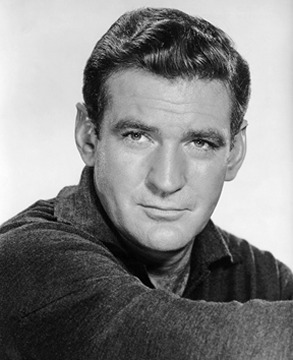
Taylor (seated) with Lloyd Bochner in the TV series Hong Kong, 1961Toward the end of 1955, Taylor unsuccessfully screen tested to play boxer Rocky Graziano in Metro-Goldwyn-Mayer’s Somebody Up There Likes Me after James Dean’s death, but his use of a Brooklyn accent and physical prowess in the test impressed the studio enough to give him a long-term contract. At MGM, he played a series of support roles in The Catered Affair (1956), Raintree County (1957), and Ask Any Girl (1959). He had a significant role in Separate Tables (1958), which won Oscars for two of its stars, David Niven and Wendy Hiller. He also made a strong impression guest-starring in an episode of The Twilight Zone titled “And When the Sky Was Opened” (1959).
Taylor’s first leading role in a feature film was in The Time Machine (1960), George Pal’s adaptation of the science-fiction classic by H.G. Wells, with Taylor as the time traveler who, thousands of years in the future, falls for a woman played by Yvette Mimieux. Taylor played a character not unlike that of his Twilight Zone episode of a year earlier and the film World Without End in 1956.In or around 1960, he was approached regarding the role of James Bond in the first feature-length Bond film. Taylor reportedly declined to become involved because he considered the character of Bond “beneath him”. Taylor later commented: “Every time a new Bond picture became a smash hit ... I tore out my hair.”
In the 1960-61 television season, Taylor starred as foreign correspondent Glenn Evans in the ABC dramatic series Hong Kong. His principal co-star was Canadian actor Lloyd Bochner; Jack Kruschen played the bartender, Tully. He voiced Pongo (a Dalmatian dog) in Disney’s animated feature, One Hundred and One Dalmatians (1961) and also guest-starred on Marilyn Maxwell’s short-lived ABC series, Bus Stop, around the same time. In 1962, he starred in an episode of NBC’s The DuPont Show of the Week (“The Ordeal of Dr. Shannon”), an adaptation of A.J. Cronin’s novel, Shannon’s Way.
Taylor starred in Alfred Hitchcock’s horror/thriller, The Birds (1963), along with Tippi Hedren, Suzanne Pleshette, a teenaged Veronica Cartwright, and Jessica Tandy, playing a man whose town and home come under attack by menacing birds. Taylor then starred with Jane Fonda in the romantic comedy, Sunday in New York (also 1963).
During the mid-1960s, Taylor worked mostly for MGM. His credits including The V.I.P.s (1963), his first feature film role as an Australian, with Richard Burton, Elizabeth Taylor, and Maggie Smith; Fate Is the Hunter (for 20th Century Fox, 1964) with Glenn Ford and Suzanne Pleshette; 36 Hours (1964) with James Garner; Young Cassidy (1965) with Julie Christie and Maggie Smith; The Liquidator (1965) with Jill St. John; Do Not Disturb (1965); and The Glass Bottom Boat (1966), the latter two co-starring Doris Day.He began to change his image toward the end of the decade to more tough-guy roles, such as Chuka (1967), which he also produced, and he starred in Dark of the Sun (or The Mercenaries, 1968), again with Yvette Mimieux; Nobody Runs Forever (1968), where he played New South Wales Police Sergeant Scobie Malone, this being Taylor’s first starring feature film role as an Australian; and Darker than Amber (1970) as Travis McGee.
His career came to an end in 2009’s “Inglorious Bastards.” Taylor played Winston Churchill in the Brad Pitt vehicle.
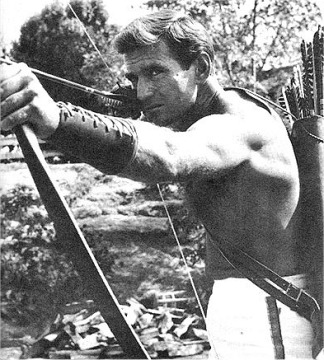
Thanks to Rob Donkers for this photo
Tarzan number two was Lloyd Berrell. Born on February 13, 1926, he died on December 30, 1957. He was a New Zealand actor who played Reuben “Roo” Webber in the original Sydney production of Summer of the Seventeenth Doll. He worked extensively in Australian radio and theatre, and appeared in a large portion of the few films being shot locally at the time. He also starred in the original stage production of Sumner Locke Elliott’s Rusty Bugles, as well as a number of productions for the Mercury Theatre.Berrell was born in Wellington, the only son of a doctor and his wife who moved to Australia when Berrell was a boy. He began acting on radio as a child, including appearing on The Youth Show. He did a variety of roles.
He received acclaim for playing the title role in the radio play Ned Kelly in 1942.
In 1944, Berrell was questioned by police for his role in disturbances in a strike by Actors Equity.
During World War II he served in the Australian Broadcast Control Unit from 1944 to 1946. In 1945 he was in Sons of the Morning on stage at the New Theatre.
In 1948, Berrell had a key role in the play Rusty Bugles, which had a long run. That year he performed in A Pickwick Story for Mercury Mobile Players, a company originally established by Peter Finch.
By 1948 he was earned over 1,000 pounds a year, mostly in radio. In 1950 he was in a production of Julius Caesar at the Independent Theatre alongside Rod Taylor. Berrell did voice over for the documentary Fighting Blood (1951).
Berrell was in several plays at the Mercury Theatre in Sydney in 1952, including The Twins, Point of Departure, and The Happy Time.
In 1953 he won a Macquarie Award for best actor in a radio drama. He also took the lead in the Australian radio version of Tom Corbett Space Cadet for Artransa in 1953.
Since Berrell passed away in 1957, his television and movie appearances were limited, because few films were made in Australia in the 1950s, however Byron Haskin used some Australian actors in His Majesty O’Keefe (1954), shot in Fiji, including Berrell.
Berrell was cast as the villain in King of the Coral Sea (1954), a rare Australian financed feature of the time, then Haskin used him again in Long John Silver (1954), filmed in Australia.
In 1946, he married Mary Mildred Haigh at Woollahra. After their highly publicized divorce in 1948, he married actress and artist, “Betty” Ruby Elizabeth Leggo in 1952. In 1953 he won the Macquarie best male actor award alongside Margaret Christensen as best female.
He died on December 30, 1957 in a flu epidemic at sea traveling to Europe.
Tarzan number three on Australian radio was Ray Barrett. Raymond Charles Barrett was born May 2, 1927 and died on September 8, 2009. During the 1960s, he was a leading actor on British television, where he was best known for his appearances in The Troubleshooters (1965-71). From the 1970s, he appeared in lead and character roles in a number of Australian films and TV series.Ray Barrett first appeared on radio in Brisbane, and later in Sydney, to where he moved in 1954. In 1957, he moved to Britain, where his background as a singer earned him a part in a revue alongside Beryl Reid, Patrick Wymark, and Sheila Hancock.
Due to his “tough looks,” Barrett was given character and “tough guy“ roles from an unusually young age. In Britain, he played one of the lead roles in the TV series, Emergency – Ward 10.
He also provided the voice of several characters in Gerry Anderson-produced “Supermarionation” series of the 1960s: Commander Shore and Titan in Stingray (1964-65) and later John Tracy, the Hood, and various extras in Thunderbirds (1965-66). Also in 1965, he appeared as Bennett/Koquillion in the Doctor Who serial, The Rescue.
He died on September 8, 2009 at the Gold Coast Hospital in Southport, Queensland, aged 82, after suffering a brain hemorrhage. His final acting appearance had been in the 2008 film Australia.
The first Jane on Australian radio was Marcia Hathaway, born on February 8, 1930 in Milsons Point, New South Wales, Australia as Marcia Nellie Hathaway. She appeared in the films Shadow of the Boomerang (1960) and Harlequinade (1961). She died on January 28, 1963 in Sydney, New South Wales.Marcia Hathaway was a talented young stage, TV, and radio actress (she was Jane to Rod Taylor’s Tarzan on the Macquarie Network) and the last person to be killed by a shark in Sydney Harbour.
It happened in Sugarloaf Bay, where she was aboard the cabin cruiser Valeeta with her fiancée and friends. With her porcelain white skin, nobody believed Marcia had ever seen the sun and they dared her to prove she could swim. So she slipped over the side of the boat into Sugarloaf Bay and the jaws of a Bull Shark (Carcharhinus leucas).
Here’s the incident report from http://sharkattackfile.net/spreadsheets/pdf directory/1963.01.28-Hathaway.pdf. I have copied the report verbatim and made no corrections to spelling, grammar, or capitalization.
ACTIVITY: Wading CASE: GSAF 1963.01.28 DATE: Monday January 28, 1963 LOCATION: The incident took place in Sugarloaf Bay in Middle Harbour, Sydney, New South Wales, Australia. 33º48’S, 151ºE NAME: Marcia Hathaway, DESCRIPTION: A 32-year-old female from Milsons Point. She was an actress and had played in music halls with touring troupes as well as radio serials. She landed a leading role in a movie, The Shadow of the Boomerang, produced by World Wide Pictures, part of the Billy Graham organization in which she played the part of an Australian mission nurse. BACKGROUND WEATHER: It was a bright and sunny, hot sultry day. The air temperature was about 80ºF and there was a slight north-northeasterly breeze. MOON PHASE: New Moon, January 25, 1963 SEA CONDITIONS: The water was murky. ENVIRONMENT: The Sydney Morning Herald warned Australia Day holidaymakers that sharks were in the area. Beach patrol aircraft had sighted 66 sharks off the Northern Beaches, shark alarms were sounded at eight beaches and Narrabeen was closed for two-and-a-half hours. A former shark net contractor was quoted as saying that 95 per cent of shark attacks around Sydney occurred between December and February. “Surfers and harbour swimmers should take particular care for the next few days,” he warned. DISTANCE FROM SHORE: 20 feet DEPTH OF WATER AT INCIDENT SITE: 30 inches TIME: 13h30 NARRATIVE: Marcia Hathaway, her fiance Frederick Knight and four friends arrived at Sugarloaf Bay onboard the cabin cruiser Valeeta for a picnic.Two of the group were on the rocks gathering oysters and others were on the beach when Hathaway and Knight entered the water. Just five minutes later, Hathway screamed that she had been bitten by an octopus, she thought. Knight was close to her when the shark bit her right leg below the calf, then bit her a second time on the thigh. As others from their party rushed to help, Knight pulled Hathaway from the shark and carried her to the boat. INJURY: The second bite caused the most damage; it severed Hathaway’s femoral artery © Global Shark Accident File, 1992. All rights reserved. This report may not be reproduced or abridged without written permission of the Global Shark Accident File Marcia Hathaway Image Source: News Limited and nearly severed her leg. She suffered a gaping wound on the anterior of her right thigh, a gaping wound on the buttock, and lacerations on the right calf, medial surface of the left thigh, and there were defense wounds on her left hand. FIRST AID: The cruiser went to the nearest boat shed. Knight dived into the water and swam to the closest house where he telephoned for help, and an ambulance was waiting at the jetty when the boat arrived. The ambulance burned out its clutch climbing the hill despite efforts of volunteers to push it over the rise. A second ambulance was called but arrived too late. She died enroute to Mater Misericordiae Hospital in North Sydney from blood loss and shock. SPECIES INVOLVED: Tooth fragments of the shark were recovered and identified as those of a “whaler,” but their whereabouts are unknown. Most researchers believe that the incident involved a bull shark, C. leucas. SOURCES: Dr. P.R. Coyne, Mater Misericordiae Hospital, North Sydney Alan Sharpe, Down Under-Shark Attacks in Australian Waters. pages 7-12 Hugh Edwards, Shark, The Shadow Below, pages 102 & 108 Peter Munro, The Age, January 28, 2013; http://www.theage.com.au/nsw/fifty-years-sincefatal-shark-attack-in-sydney-harbour-20130127-2dey8.html © Global Shark Accident File, 1992.
Pamela Page, the second Jane, was born in 1925 in Paddington, London, England as Pamela Mary Page. She was an actress, known for Homicide (1964), Sons and Daughters (1982), and Catwalk (1971). She also appeared in the TV series, Pot of Gold, Counterpoints, and Consider Your Verdict. She made a couple of made for television movies The Big Client and The Grey Nurse Said Nothing. She was married to Norris Stayton. She died on October 3, 1987 in Bayview, Sydney, New South Wales, Australia. She played Jane on the 1950s Australian Tarzan radio show after Marcia Hathaway.I did not reproduce a photograph of Ms. Page. Every picture I could find was copyrighted by Getty Images and the cost for utilization ranged from $200 US to $500 US. I believe they’d enforce their copyrights, so no photo.
The third woman to play Jane on Australian radio was Joan Landor. She is credited as being one of the cofounders of the Mercury Theatre, an Australian theatre company that was co-founded by Peter Finch and existed from 1946 to 1954. It was named after the American Orson Welles’ theatre company of the same name. I couldn’t find a biography of the actress, or a photograph for that matter. She appeared on numerous Australian radio shows in the early 1950s, including Ellery Queen and The Clock.
The series narrator was Roger Climpson, a man whose last name is pronounced like a lot of folks pronounce the name of a university in South Carolina, Clemson. In Roger’s case, the ‘P” is not invisible.Roger Climpson was born October 18, 1931 and, as of January 12, 2020, he is a retired English-born Australian media personality who had a lengthy career in both radio and television, as a journalist, announcer, newsman, and presenter. He is best known for his time at Seven News in the 1980s and 1990s and for his hosting duties on shows from 1977 until 1998, such as the local version of This Is Your Life and true-crime series Australia’s Most Wanted. Climpson was born in Peterborough, England. The son of a butcher, he hoped to become a pilot in the Royal Air Force, until a rugby union accident at the age of 14 punctured his lung. He took up acting instead of flying. He immigrated to Australia in 1949, and met his future wife, Claire, in 1952.
His television career began in 1957, working at Channel Nine as an announcer, weatherman, and newsman.. During his time at Channel Nine, he hosted two programs of his own: Rendezvous with Roger and The House and Garden Show. It is likely during this period that Climpson did the on-air news report of his fellow Tarzan actress, Marcia
He left Channel Nine in 1965 after chairman Sir Frank Packer refused to give him a five-pound pay raise. Climpson found himself briefly unemployed and worked at his father’s butcher shop, until he was asked to fill a temporary newsman role at Channel Seven – where he stayed for fifteen years.In 1977, he began hosting This Is Your Life until returning to broadcasting in 1978. In 1982, Climpson retired from television work, but returned to the station in 1989 as anchor of Sydney’s Seven News, until a diagnosis of prostate cancer in November 1994 forced his temporary retirement. In 1997, he was host of Australia’s Most Wanted, which lasted until 1998 when he retired from television.
Hathaway’s shark attack in Sydney Harbor.
Nigel Lovell voiced parts in Tarzan, King of the Apes. He was born on January 27, 1916 in Sydney, New South Wales, Australia as Nigel Tasman Lovell. He was an actor and producer, known for Massacre Hill (1949), Hunter (1967) and Ned Kelly (1970). He died on December 3, 2001 in Sydney.Nigel met his second wife, actress Patricia Lovell, through the Metropolitan Theatre. He was a widower with a daughter. They married in 1956, and had two children, Simon Lovell, a helicopter pilot, and Jenny Lovell, an actress known for her role on the soap opera Prisoner (called Prisoner: Cell Block H in the United Kingdom and the USA).
The last actor I can verify appeared in Tarzan, King of the Apes is Charles “Bud” Tingwell. Tingwell is better known internationally than any other person who appeared in Tarzan, including possibly Rod Taylor. Tingwell had a small part in Tarzan the Magnificent.Charles William Tingwell was born January 3, 1923 and died on May 15, 2009. He acted in his first motion picture in 1946 and went on to appear in more than 100 films and numerous TV programs in both the United Kingdom and Australia.
While still at school, he became a cadet at Sydney radio station 2CH, soon becoming the youngest radio announcer in Australia.
In 1941, Tingwell enlisted war service overseas with the Royal Australian Air Force. Under the British Commonwealth Air Training Plan, personnel from Commonwealth air forces formed part of a joint training and assignment system. Tingwell trained as a pilot in Canada during 1942 and was commissioned as a pilot that December. He was posted to the Mediterranean Theatre and underwent operational training with No. 74 Operational Training Unit RAF, in British Palestine, and qualified to fly the Hawker Hurricane and Supermarine Spitfire.
Later, he was posted to a photo reconnaissance unit, No. 680 Squadron RAF, and flew 75 sorties in Mosquitos and Spitfires during the North African Campaign and the Allied invasion of Sicily. Toward the end of the war, Tingwell was transferred back to Australia. He was posted to No. 5 Operational Training Unit RAAF as a flying instructor and then to No. 87 Squadron RAAF, flying photo reconnaissance Mosquitoes over the Dutch East Indies.
After returning to Australia, Tingwell married his childhood sweetheart, Audrey May Wilson, who died in 1996.
He joined Doris Fitton’s Independent Theatre group and appeared on stage from the mid-1940s in such classics as The Little Foxes by Lillian Hellman and Jean Giraudoux’s The Madwoman of Chaillot.
In 1946, Tingwell was given his first film role, as a control tower officer in Smithy.
Tingwell had a supporting part in Bitter Springs (1950), made by Ealing Studios with Chips Rafferty; Tingwell played Rafferty’s bigoted son. He had a similar role in Kangaroo (1952), a Hollywood-financed film shot in Australia for 20th Century Fox. He then appeared in I Found Joe Barton (1952), the first TV show shot in Australia.
Fox liked Tingwell’s work in Kangaroo and invited him to Los Angeles to play the part of Lt Harry Carstairs in The Desert Rats, in which he appeared opposite Chips Rafferty, James Mason, and Richard Burton.
Tingwell played the lead in King of the Coral Sea (1954) alongside Rafferty. In 1954, he co-starred with Gordon Chater in Top of the Bill, the first of the famous satirical revues staged at Sydney’s Phillip Street Theatre.
In 1958, he took on his first recurring television role, as Australian surgeon Alan Dawson in the live TV serial Emergency – Ward 10 and its film spin-off, Life in Emergency Ward 10 (1959).
He had small roles in Ealing’s Dunkirk (1958), then Bobbikins (1959), Cone of Silence (1960), and Tarzan the Magnificent (1960).
Tingwell played the role of Inspector Craddock in all four films of the Miss Marple series starring Margaret Rutherford, from 1961 to 1964: Murder, She Said (1961), Murder at the Gallop (1963), Murder Most Foul (1964), and Murder Ahoy! (1964). For Hammer Films he appeared in The Secret of Blood Island (1964).
In 2004, Tingwell published a memoir, Bud: A Life. In 2006, he launched his own website, which attracted 500 registered users in just over a week. On 5 October that year, he created his first blog. He continued to act regularly until his death in a number of films and TV programs, including eight episodes of Bed of Roses that aired in 2010. Among his last appearances, he hosted both Celebrity Circus and 20 to 1.
.
Three Tarzans and three Janes and a handful of sidekicks. Some became famous and some didn’t. Over 1000 12 minute episodes were produced, but only two are available – how sad.
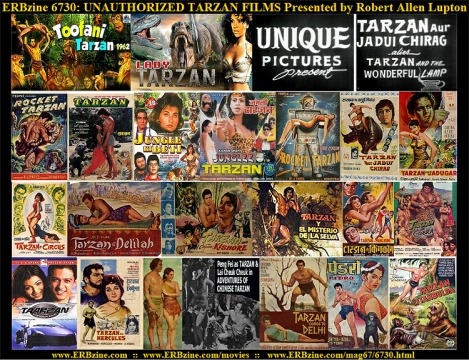
![]()

THE 100-WORD ERB DRABBLE SERIES
by ROBERT ALLEN LUPTON
LISTEN TO THE AMERICAN PRODUCED
TARZAN RADIO SHOWS IN ERBzine
Radio's
Golden Age in ERBzine
1932
Series: LISTEN TO ALL 77 EPISODES HERE
1934
Series: LISTEN TO ALL 39 EPISODES HERE
1936
Series: LISTEN TO ALL 39 EPISODES HERE
1951-1953
Series: LISTEN
TO ALL THE SHOWS
AND
READ THE LOGS HERE
Listen
to ERB Speak On The Air: "The Apes of Wrath"
Two of the episodes are available at:
www.erbzine.com/mag0/tarzanoz1.mp3
www.erbzine.com/mag0/tarzanoz2.mp3
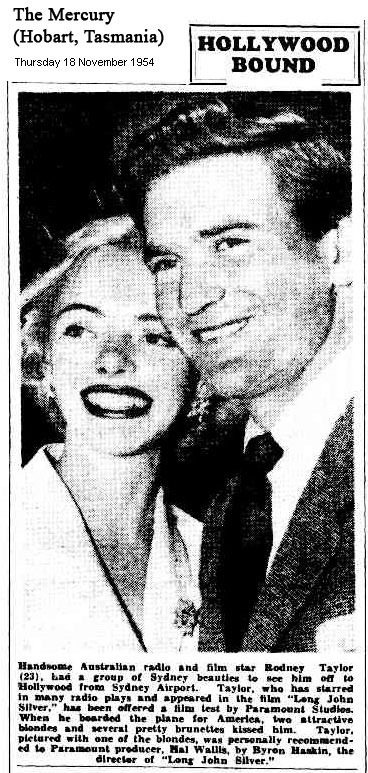
www.rodtaylorsite.com/radio.shtml
![]()
ALL THE ERB-RELATED FEATURES IN ERBzine.com
By ROBERT ALLAN LUPTON
www.ERBzine.com/lupton
![]()

BILL
HILLMAN
Visit
our thousands of other sites at:
BILL
AND SUE-ON HILLMAN ECLECTIC STUDIO
ERB
Text, ERB Images and Tarzan® are ©Edgar Rice Burroughs, Inc.-
All Rights Reserved.
All
Original Work ©1996-2020 by Bill Hillman and/or Contributing Authors/Owners
No
part of this web site may be reproduced without permission from the respective
owners.